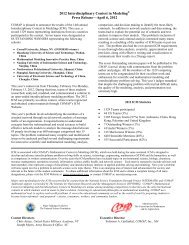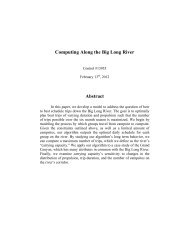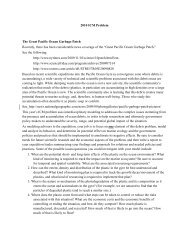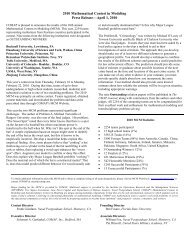Centroids, Clusters and Crime: Anchoring the Geographic Profiles of ...
Centroids, Clusters and Crime: Anchoring the Geographic Profiles of ...
Centroids, Clusters and Crime: Anchoring the Geographic Profiles of ...
You also want an ePaper? Increase the reach of your titles
YUMPU automatically turns print PDFs into web optimized ePapers that Google loves.
Team # 7507 Page 37<br />
provides a ballpark estimate <strong>of</strong> our confidence in <strong>the</strong> model. Note that in <strong>the</strong> two more wellbehaved<br />
cases, <strong>the</strong> model with <strong>the</strong> higher projected effectiveness κ s is in fact <strong>the</strong> more effective<br />
model in reality. Moreover, by simply properties <strong>of</strong> averages, it should be true that to within<br />
<strong>the</strong> level <strong>of</strong> uncertainty created by <strong>the</strong> number <strong>of</strong> points in <strong>the</strong> data-set, when one compares size<br />
<strong>of</strong> κ s for <strong>the</strong> same model on two different data sets, <strong>the</strong> one with <strong>the</strong> larger κ s will on average<br />
be <strong>the</strong> more trustworthy.<br />
9.1.1 The Psychic, <strong>the</strong> Hairfinder, <strong>and</strong> <strong>the</strong> Intuitive Cop<br />
Although <strong>the</strong> size <strong>of</strong> our datasets will not allow us to demonstrate anything conclusively, <strong>the</strong><br />
model we develop is a strong c<strong>and</strong>idate to beat <strong>the</strong> psychic <strong>and</strong> <strong>the</strong> hairfinder (r<strong>and</strong>om chance),<br />
for several reasons.<br />
• The predictions are based on <strong>the</strong> assumption <strong>of</strong> trends in serial crime behavior which<br />
have been tested on large sets <strong>of</strong> real-world data. [12] [2] [8]<br />
• Similar ma<strong>the</strong>matical techniques are used in <strong>the</strong> anchor-point estimation schemes currently<br />
being employed <strong>and</strong> researched, which also consistently outperform r<strong>and</strong>om guesses<br />
when tested across data samples<br />
• The model was successful in <strong>the</strong> two <strong>of</strong> <strong>the</strong> three datasets on which it was tested, <strong>and</strong><br />
<strong>the</strong>se datasets were selected from preexisting research as representative samples <strong>of</strong> serial<br />
crime data<br />
• Several crimes in each dataset can be predicted well, including <strong>the</strong> case where our model<br />
fails to predict <strong>the</strong> final, outlier crime point– i.e., in a dataset <strong>of</strong> 16 crimes, we are also<br />
<strong>of</strong>ten able to predict <strong>the</strong> 15 crime using <strong>the</strong> preceding 14, <strong>the</strong> 14th using <strong>the</strong> preceding<br />
13, etc., all with more success than a r<strong>and</strong>om guess.<br />
This evidence suggests, without proving, that on average, our model will be better than<br />
blind chance. We do not, however, make <strong>the</strong> claim that we will do better than a police department<br />
assigning resources based <strong>of</strong>f no model at all. In <strong>the</strong> absence <strong>of</strong> ma<strong>the</strong>matical guidance,<br />
a policeman in such a department would have rely on his own knowledge <strong>of</strong> his patrol area,<br />
his sense <strong>of</strong> patterning in <strong>the</strong> <strong>of</strong>fender’s crimes, <strong>and</strong> any “ gut feelings” he developed about<br />
<strong>the</strong> <strong>of</strong>fender’s psychology, based on his previous experience in law enforcement. This “Intuitive<br />
Cop” has considerably more information at his disposal than our model, as he knows,<br />
for example, that a killer targeting prostitutes is more likely to strike in <strong>the</strong> red-light district<br />
<strong>of</strong> his city. Additionally, research suggests that with a little informal training, any layperson<br />
can perform nearly as well as anchor point prediction algorithms when guessing a criminal’s
















